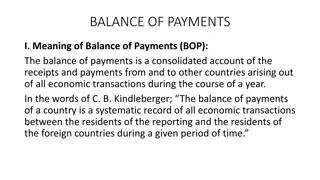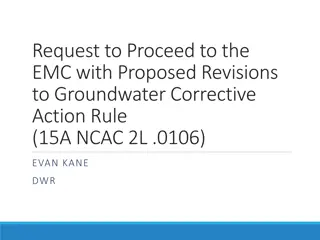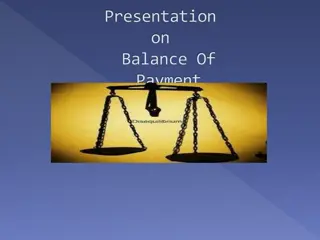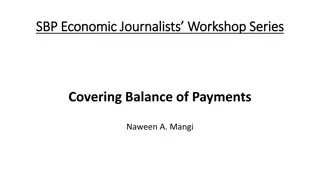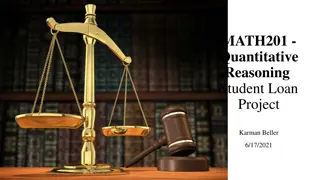Understanding Disequilibrium and Corrective Measures in Balance of Payments
Causes of disequilibrium in Balance of Payments (BoP) include cyclical, structural, and short-run imbalances. Cyclical disequilibrium relates to trade cycles, structural imbalance arises from sectoral changes impacting trade relations, and short-run imbalances are temporary and often related to borrowing or lending internationally. Measures to correct disequilibrium involve addressing fluctuations in demand, structural changes, and managing short-term imbalances in exports and imports.
Download Presentation

Please find below an Image/Link to download the presentation.
The content on the website is provided AS IS for your information and personal use only. It may not be sold, licensed, or shared on other websites without obtaining consent from the author. Download presentation by click this link. If you encounter any issues during the download, it is possible that the publisher has removed the file from their server.
E N D
Presentation Transcript
CAUSES OF DISEQUILIBRIUM AND MEASURES TO CORECT DISEQUILIBRIUM IN BoP
Types of Disequilibrium Main types of disequilibrium in the balance of payments are: i. Cyclical Disequilibrium iii. Short-run Disequilibrium i. Cyclical Disequilibrium: It occurs on account of trade cycles. Depending upon the different phases of trade cycles like prosperity and depression, demand and other forces vary, causing changes in the terms of trade as well as growth of trade and accordingly a surplus or deficit will result in the balance of payments. Cyclical fluctuations cause disequilibrium in the balance of payments because of cyclical changes in income, employment, output and price variables. When prices rise during prosperity and fall during a depression, a country which has a highly elastic demand for imports experiences a decline in the value of imports and if it continues its exports further, it will show a surplus in the balance of payments. ii. Structural Disequilibrium iv. Long-run Disequilibrium
Since deficit and surplus alternatively take place during the depression and prosperity phase of a cycle, the balance of payments equilibrium is automatically set forth over the complete cycle. ii. Structural Disequilibrium: It emerges on account of structural changes occurring in some sectors of the economy at home or abroad which may alter the demand or supply relations of exports or imports or both. Suppose the foreign demand for India s jute products declines because of some substitutes, then the resources employed by India in the production of jute goods will have to be shifted to some other commodities of export. If this is not easily possible, India s exports may decline whereas with imports remaining the same, disequilibrium in the balance of payments will arise. Similarly, if the supply condition of export items is changed, i.e., supply is reduced due to crop failure in prime commodities or shortage of raw materials or labour strikes, etc. in the case of manufactured goods, then also exports may decline to that extent and structural disequilibrium in the balance of payments will arise.
Moreover, a shift in demand occurs with the changes in tastes, fashions, habits, income, economic progress, etc. Propensity to import may change as a result. Demand for some imported goods may increase, while that for certain goods may decline leading to a structural change. Furthermore, structural changes are also produced by variations in the rate of international capital movements. A rise in the inflow of international capital tends to have a direct impact on a country s balance of payments. iii. Short-run Disequilibrium: A short-run disequilibrium in a country s balance of payments will be a temporary one, lasting for a short period, which may occur once in a while. When a country borrows or lends internationally, it will have short-run disequilibrium in its balance of payments, as these loans are usually for a short period or even if they are for a long duration, they are repayable later on; hence the position will be automatically corrected and poses no serious problem.
A short-run disequilibrium may also emerge if a countrys imports exceed its exports in a given year. This will be a temporary one if it occurs once in a way, because later on, the country will be in a position to correct it easily by creating the required credit surplus by exporting more to offset the deficit. When such disequilibrium (arising from imports exceeding exports or even vice versa) occurs year after year over a long period, it becomes chronic and may seriously affect the country s economy and its international economic relations. A persistent deficit will tend to deplete its foreign exchange reserves and the country may not be able to raise any more loans from foreigners.
iv. Long-run Disequilibrium: The long-term disequilibrium thus refers to a deep- rooted, persistent deficit or surplus in the balance of payments of a country. It is secular disequilibrium emerging on account of the chronologically accumulated short-term disequilibria deficits or surpluses. It endangers the exchange stability of the country concerned. Especially, a long-term deficit in the balance of payments of a country tends to deplete its foreign exchange reserves and the country may also not be able to raise any more loans from foreigners during such a period of persistent deficits. True disequilibrium is a long-term phenomenon. It is caused by persistent deep- rooted dynamic changes which slowly take place in the economy over a long period of time. It is caused by changes in dynamic forces/factors such as capital formation, population growth, territorial expansion, technological advancement, innovations, etc.
A newly developing economy, for instance, in its initial stages of growth needs huge investment exceeding its savings. In view of its low capital formation, it has also to import a large amount of its capital requirements from foreign countries and its imports thus tend to exceed its exports. These become a chronic phenomenon. And in the absence of a sufficient inflow of foreign capital in such countries, a secular deficit balance of payments may result. Causes of Disequilibrium in BOP (i) Economic Factors: (a) Imbalance between exports and imports. (b) Large scale development expenditure which causes large imports, (c) High domestic prices which lead to imports, (d) Cyclical fluctuations (like recession or depression) in general business activity, (e) New sources of supply and new substitutes.
(ii) Political Factors: The political instability and disturbances cause large capital outflows and hinder Inflows of foreign capital. (iii) Social Factors: (a) Changes in fashions, tastes and preferences of the people bring disequilibrium in BOP by influencing imports and exports; (b) High population growth in poor countries adversely affects their BOP because it increases the needs of the countries for imports and decreases their capacity to export. Measures to correct the disequilibrium in BOP 1 Trade Policy Measures: Expanding Exports and Restraining Imports: (a) Exports may be encouraged by reducing or abolishing export duties and lowering the interest rate on credit used for financing exports. Exports are also encouraged by granting subsidies to manufacturers and exporters.
(b) Lower income tax can be levied on export earnings to provide incentives to the exporters to produce and export more goods and services. By imposing lower excise duties, prices of exports can be reduced to make them competitive in the world markets. (c) Imports may be reduced by imposing or raising tariffs (i.e., import duties) on imports of goods. Imports may also be restricted through imposing import quotas, introducing licenses for imports. Imports of some inessential items may be totally prohibited. 2. Expenditure-Reducing Policies: The important way to reduce imports and thereby reduce deficit in balance of payments is to adopt monetary and fiscal policies that aim at reducing aggregate expenditure in the economy. The fall in aggregate expenditure or aggregate demand in the economy works to reduce imports and help in solving the balance of payments problem.
The two important tools of reducing aggregate expenditure are the use of: (1) Tight monetary policy and (2) Contractionary fiscal policy. Tight Monetary Policy: (a) By raising the cost of bank credit and restricting the availability of credit. For this bank rate is raised by the Central Bank of the country which leads to higher lending rates charged by the commercial banks. This discourages businessmen to borrow for investment and consumers to borrow for buying durable consumers goods. This therefore leads to the reduction in investment and consumption expenditure. (b) The availability of credit to lend for investment and consumption purposes is reduced by raising the cash reserve ratio (CRR) of the banks. (c) Undertaking of open market operations (selling Government securities in the open market) by the Central Bank of the country.
Contractionary Fiscal Policy: Appropriate fiscal policy is also an important means of reducing aggregate expenditure. (a) An increase in direct taxes such as income tax will reduce aggregate expenditure. Reduction in expenditure may lead to decrease in imports. Increase in indirect taxes such as excise duties and sales tax will also cause reduction in expenditure. (b) To reduce Government expenditure, especially unproductive or non- developmental expenditure. The cut in Government expenditure will not only reduce expenditure directly but also indirectly through the operation of multiplier. .Expenditure Switching Policies: Devaluation: Expenditure switching policies work through changes in relative prices. Prices of imports are increased by making domestically produced goods relatively cheaper.
Expenditure switching policies may lower the prices of exports which will encourage exports of a country. In this way by changing relative prices, expenditure-switching policies help in correcting disequilibrium in balance of payments. The important form of expenditure switching policy is the reduction in foreign exchange rate of the national currency, namely, devaluation. By devaluation we mean reducing the value or exchange rate of a national currency with respect to other foreign currencies. Devaluation is made when a country is under fixed exchange rate system and occasionally decides to lower the exchange rate of its currency to improve its balance of payments. However, even in the present flexible exchange rate system, the value of a currency or its exchange rate as determined by demand for and supply of it. Fall in the value of a currency with respect to foreign currencies as determined by demand and supply conditions is described as depreciation.
If a country permits its currency to depreciate without taking effective steps to check it, it will have the same effects as devaluation. As a result of reduction in the exchange rate of a currency with respect to foreign currencies, the prices of goods to be exported fall, whereas prices of imports go up. This encourages exports and discourages imports. With exports so stimulated and imports discouraged, the deficit in the balance of payments will tend to be reduced. Thus policy of devaluation is also referred to as expenditure switching policy since as a result of reduction of imports, people of a country switches their expenditure on imports to the domestically produced goods. As a result of the lowering of prices of exports, export earnings will increase if the demand for a country s exports is price elastic (i.e., er> 1). And also with the rise in prices of imports the value of imports will fall if a country s demand for imports is elastic.
If demand of a country for imports is inelastic, its expenditure on imports will rise instead of falling due to higher prices of imports. 4. Exchange Control: International Monetary Fund (IMF) was set up for maintaining equilibrium in the balance of payments of member countries for a short term. Member countries borrow from it for a short period to maintain equilibrium in the balance of payments. IMF also advises member countries how to correct fundamental disequilibrium in the balance of Payments when it does arise. q








